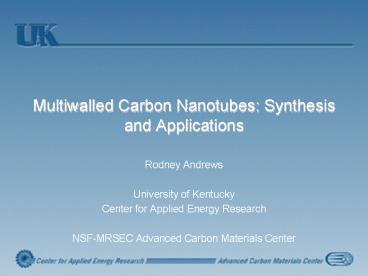Multiwalled Carbon Nanotubes: Synthesis and Applications - PowerPoint PPT Presentation
1 / 53
Title:
Multiwalled Carbon Nanotubes: Synthesis and Applications
Description:
NSF-MRSEC Advanced Carbon Materials Center. Carbon Fiber Diameters ... Surfactant assisted. Tensile strength and modulus. Experimental and Theoretical Moduli ... – PowerPoint PPT presentation
Number of Views:2641
Avg rating:5.0/5.0
Title: Multiwalled Carbon Nanotubes: Synthesis and Applications
1
Multiwalled Carbon Nanotubes Synthesis and
Applications
- Rodney Andrews
- University of Kentucky
- Center for Applied Energy Research
- NSF-MRSEC Advanced Carbon Materials Center
2
Carbon Fiber Diameters
3
Nanotube Applications
- Nano-electronics
- Metallic and semi-conducting varieties
- Molecular circuits
- Electromagnetic interference shielding
- Stealth composites and coatings
4
Nanotube Applications
- Energy Storage
- Hydrogen storage
- Super-capacitors and batteries
- Field emission devices
- Flat panel displays
5
High Strength to Weight Materials
6
Enabling Technology
- Need for viable synthesis technology
- Large scale
- Low cost
- High purity
- Controlled properties
- Lack of entanglement
- Easily separable
- Currently this does not exist
7
Commercial Processes
- SWNT
- MER Corp. 250 g/day (US)
- Carbolex 50 g/day (US)
- Tubes_at_Rice (US)
- Nanoledge (France)
- MWNT
- MER Corp. 2 kg/day (US)
- Hyperion Catalysis 80 kg/day (US)
8
Commercial Processes
- CVD MWNT
- Showa Denko 40,000 kg/yr (Japan)
- Nikkiso (Japan)
- Fullerene International Technologies
- MER-Mitsubishi joint venture
- Based on MERs arc technology
9
CVD Synthesis of MWNT
- You meant to coke the catalyst?
10
MWNT Process Developed at CAER
- Vapor Growth (CVD) Process
- quartz tube furnace
- quartz plate substrates
- Ar/H2 atmosphere
- liquid feed
- xylene as hydrocarbon source
- ferrocene catalyst
- controlled injection rate
- Product
- high purity (gt95 MWNT produced)
- 60-65 carbon conversion to MWNT
- aligned mats normal to growth surface
R. Andrews et al., Chem Phys Lets, 303 (1999)
467-474.
11
SEM of High Purity MWNT Arrays
12
HRTEM of a Single MWNT
13
Reactor System
14
Parameters Studied
15
Temperature of Reaction Zone
16
Carbon Partial Pressure
17
Catalyst Loading
- Production rate increases with FeC ratio
- Diameter distribution widens
18
Distribution of MWNT Diameters
Diameter function of temperature, partial
pressure and time.
19
Outer diameter relates to particle size.
Core diameter is constant (3-10 nm, average of
6nm)
20
Growth Mechanism
- Form of carbon depends on metal particle size
- graphite
- graphite whiskers (VGCF)
- nanofibers
- MWNT
- SWNT
- As metal becomes smaller
- curvature is eventually favored (MWNT)
- ultimately, SWNT is only stable form
21
Lawn Growth Mechanism
- Growth on substrates and walls
- metal particle seeds growth
- extrusion up from surface
- tip growth following a particle
22
Nanotube Composites
- You want how many grams of nanotubes?
23
Difficulties in Use of Nanotubes
- Purity is an issue working in this field
- B. McEnaney, 18 Oct, 2000
- Supply problem
- Nanotube form effects dispersability
- Entanglement (birds nest)
- Physical linkages
24
Literature Review
- Recent search yielded 100 articles on nanotube
composite materials - Topics covered include
- Nanotube-polymer composites
- Metal-matrix nanotube composites
- Nanotube-glass composites
- Nanotube-carbon composites
25
MWNT Materials
- CVD synthesis
- xylene / ferrocene
- low temperature, 725 oC
- high purity, gt 95
26
Pyrograf III
- Nanofibers
- Applied Sciences, Inc.
- entangled
- some pyrolytic carbon
- commercially available
- lower cost, 65/lb
27
Solution Processing
28
Dispersion to single MWNT level
- Ultrasonic mixing
- Individual dispersion
- Surfactant assisted
29
Tensile strength and modulus
30
Experimental and Theoretical Moduli
31
Alignment in shear field
32
Melt Processing Shear Mixing
33
Shear Mixing of MWNT into Polymers
- Haake Polylab Shear Mixer
- 50 gram charges
- 0 - 25 wt fiber
- Matrices
- HIPS
- PP
- ABS
- Pitch
- Mixing Energy
34
Dispersion of MWNT in PP
- Determination
- Optical microscopy
- SEM and TEM
- 0 - 10 rating
35
Mixing Energy Increases with Loading
36
Mixing Energy for Dispersion
MWNT in HIPS
37
Melt Processing
- Thin Films
38
Surface resistivity
39
Conductive Plastics
- Current technology
- carbon blacks
- 10-15 loadings
- loss of mechanical properties
- MWNT Composites
- 0.1 - 1 wt loadings
- low percolation threshold
- tunable
40
Melt Processing
- Polymer and Pitch Fibers
41
Fiber Formation
1 mm die, L/D 20
Composite Filament
Rotating wind-up drum
42
Polymer Fibers with Aligned MWNT
43
MWNT/PP Fibers
44
Carbon Fiber with 1wt MWNT
45
Carbon fiber with 2wt MWNT
46
MWNT-Pitch Fibers
- Western KY Coal Extract Pitch
- Strength 373 MPa
- Modulus 28.7 GPa
- WKy 1 wt MWNT
- Strength 506 MPa
- Modulus 34 GPa
- Aromaticity of pitch seems to aid dispersion
47
Failure of NT-Composite Materials
48
NT-Composite Failure(Dickey)
Sword-in-sheath fracture
MWNTs align normal to the crack direction as
they bridge the crack
a. nanotube fracture in crack wake b. debonding
at nanotube-PS interface c. cavities from
nanotube pullout
49
Failure modes of MWNT Composites
- Bridging during crack formation
- Good adhesion
- telescopic failure
- Poor adhesion
- MWNT pull-out
50
Telescopic failure
- sword-in-sheath
- Good MWNT-matrix adhesion
- Outer shells fail at some defect
- Inner shells slide out intact
51
MWNT Reinforcement
- Tensile properties
- Large enhancement in modulus
- Little effect on tensile strength
- Similar to what has been seen in VGCF composites
(ref. Tibbetts) - Compressive properties
- Similar to tensile
- Tensile/compressive ? 1 with increasing
structural perfection (ref. Wagner)
52
Benzyne Functionalization of MWNT(Meier, Andrews)
- Benzyne addition
- on sidewall of MWNT
- Composite polystyrene films
- Improved dispersion
- Improved matrix-nanotube adhesion
- Results
- Good dispersion
- Reduction in film brittleness
- Improved flexibility over blank films and
unfunctionalized MWNT composites - Increased flexural strength!!
53
Acknowledgements































